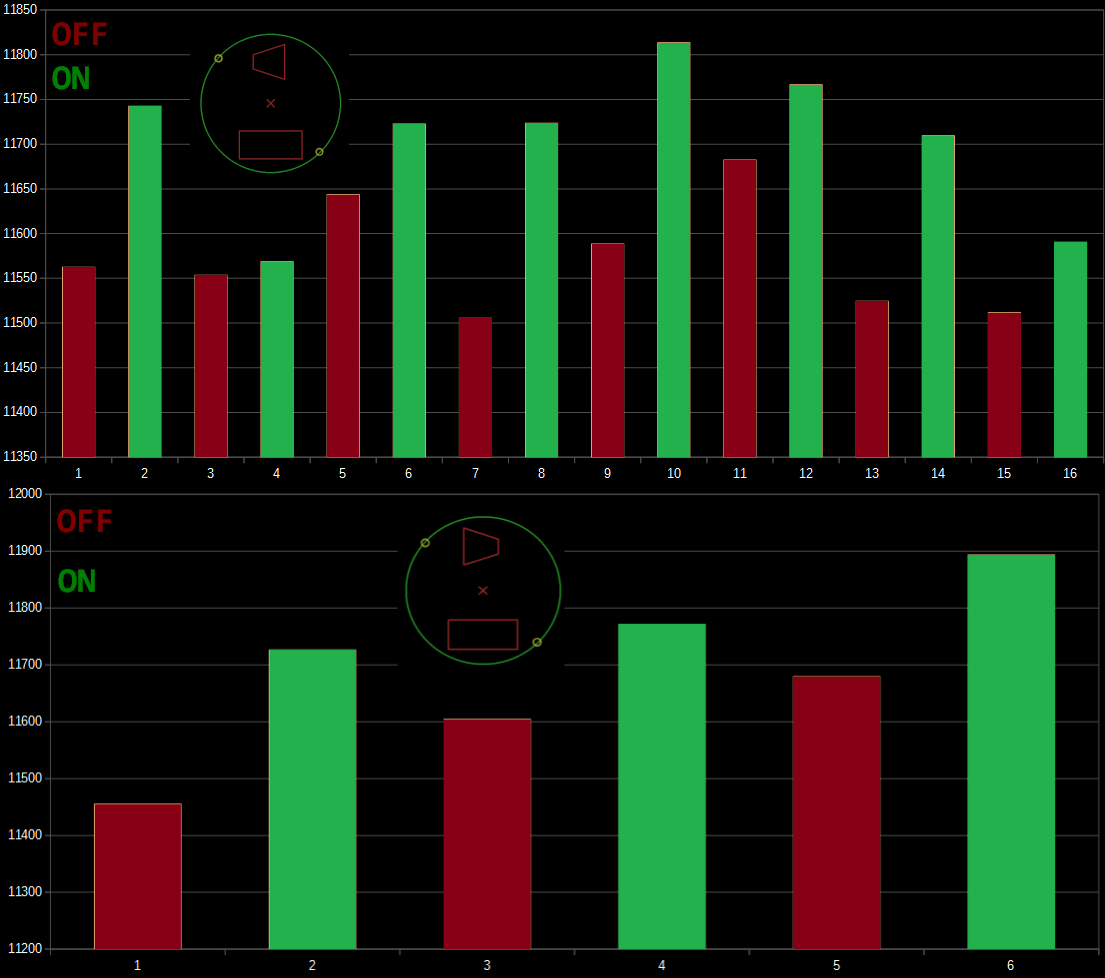I ran two clean tests with cavity mounted CW and CCW.
What looks like thrust on the first sight turns out to be a parasitic force that turns the platform always in the same direction :(
So it must be some current or thermal effect in the system. My guess are lorentz forces.
I don´t know how to get rid of this effect, it will make measurements really hard.
I could compare the differences between the ON/OFF phases of the two tests to get some clues, but because the baseline is always fluctuating it´s hard to see.
And the baseline also changes when the cavity is turned around due to the different mass distribution on the platform (magnet gets realigned a little and causes slight position change?)
Do you have any suggestions?
X-Axis: on/off phases, ca. 30min each
Y-Axis: platform angle in 1/100°
Means of the first graph: 11563 11743 11554 11569 11644 11723 11506 11724 11589 11814 11683 11767 11525 11710 11512 11591
and of the second graph: 11456 11727 11605 11772 11680 11894

 Paul Kocyla
Paul Kocyla
Discussions
Become a Hackaday.io Member
Create an account to leave a comment. Already have an account? Log In.
Have you thought of measuring ambient EM field levels both with the emdrive off and on while measuring the position of the floatingplatform. A long baseline test with the emdrive off (and in both orientations) simply measuring the strength of the EM fields could be helpful to distinguish the effects of EM sources from any propellantless emdrive thrust.
There are a few inexpensive sensors available that can measure magnetic field strength down to nanotelsa (not sure if you would need that level of sensitivity, but some people have used them to try to predict earthquakes).
Are you sure? yes | no
I agree. The thrust, regardless of the setup, will probably be very low because of the lower power being used. At these low thrust levels, it may be difficult to discern anything from looking at individual on and off periods. A large number of runs will likely be needed and the results assessed statistically.
The levitated platform was ideal, because the small force would aggregate continuously, affecting the decay rate over the entire run. However, even with this method, the force may be so small that a large number of runs would still be needed for the null, prograde and retrograde orientation and the results assessed statistically.
Are you sure? yes | no
Yes. That´s why we will make a big change in the setup and integrate a controllable RF source with more power and a tuneable cavity.
The magnetic platform would be great, but it would be also time consuming to build one. I´ll keep the eyes open for large solenoids and will check out some schematics for analogue feedback. The digital ones tend to vibrate too much.
Are you sure? yes | no
Suppose we have a constant force in one direction (the supposed Lorentz force), and a variable force in opposite directions (the EM drive).
Then the difference between on and off phases should be greater in one condition than in the other condition, because in one condition they push in the same direction, and in one they push in opposite directions.
That's why I tested if the angle differences are significantly different between conditions. These are my intermediate results:
CW: -180 -15 -79 -218 -225 -84 -185 -79
CCW: -271 -167 -214
I then run a Wilcoxon rank sum test on these results. That's a very conservative test that assumes almost nothing about the data.
It showed that there is a 27% likelihood that both data sets are identical. This is your current significance level, and it's not terribly great in itself. In science, a significance level of 3.4ppm (0.00034%) counts as irrefutable proof, 0.1% is quite convincing, and 5-10% counts as "suggestive of a trend". But you have very few data points, and this result could improve drastically with more data. For example, Facebook found a tiny effect that all psychologists missed before, simply because they compared millions of users.
I'm actually somewhat excited by these measurements. Don't mind the baseline shift. If you don't intend to physically improve this platform (e.g., bigger battery), please run it as long and as often as you can. Think thousands rather than dozens of run segments. We'll see if the percentage drops with more data. It should trend to 0% if the EMdrive works, and to 100% if it doesn't.
PS: With your setup (cw vs. ccw), environmental noise doesn't hurt your results any more, it simply means "more noise" -> "more data points required before there's a significant result". Of course, getting rid of noise would make measuring much less time consuming. But you're on the right track here.
PPS: If you change anything about the setup besides changing batteries and reversing cavity orientation, consider that as the beginning of a new experiment. I have a suspicion that even the absolute orientation of the tub may be critical.
Are you sure? yes | no
Thanx very much for the analysis. It´s good to hear that we are on the right track.
Before continuing with the tests, we will improve the RF source and cavity. We will have much more RF power and a variable endplate.
After that we will run many many tests as you proposed and hope for good results.
Are you sure? yes | no